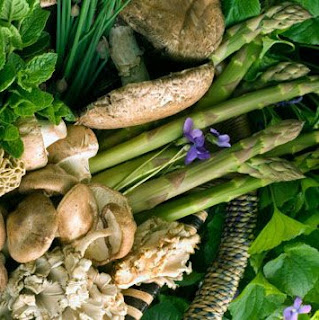Before the advent of farms humans had to forage and hunt for their food. If you wanted fruits, vegetables or other plant matter for your diet you needed to harvest them from the wild. Farming and genetically modified crops has made the need for foraging unnecessary. Farm grown crops are bigger, more nutritious and grow faster. However, there has been a trend lately of people wanting to avoid GMOs and acquire ever more fresher ingredients. Many people build and maintain backyard gardens with great results but many others don't have this opportunity. There are also certain crops that are notoriously hard to grow such as mushrooms. This has made people turn to wild harvesting or foraging. Anglers and hunters do this since they are already out in the wild and the rule of thumb is "whatever grows together, goes together."
Wild edibles are more numerous then everyone realizes. It just takes a little education and research to be able to identify what is edible and what could make you sick. It goes without saying that you should be very careful when harvesting wild edibles because some can actually kill you, especially mushrooms which conversely are highly sought after.
When trying to identify what is edible and what is not you need to match the plant or animal with a written scientific description and not just comparing pictures. There are plants that look very similar but have slight variations that you will need to identify first. If you are unsure about something then just leave it.
Is it Legal?
Before you start you must research the laws of your municipality first. Taking anything from private land is definitely illegal unless you have permission from the owner so make sure you are not trespassing. If you happen to go to a park or conservation area there should be signs and other information posted at the entrance that states what is not allowed in the park. This could include no hunting, fishing or foraging among other things. A municipality may also have areas that are set aside that also do not allow this but may or may not be marked so be careful. One other thing you should be aware of is what plants you cant pick or forage at all. These include state or provincial flowers and endangered plants.
It goes without saying at this point that you should be researching the common plants that could hurt you if you even touch them. These would be poison ivy, poison oak and poison sumac which are very common in North America.
What's in Your Area?
Of course you will need to know what is growing in your area since the availability of certain things may change from one place to the next. If you search online there will be many sites listing the wild plants found near you. Your municipality's website may also have a list so you could check there too. The information you will want in order to get started is a detailed description, picture, and growing season. Picking something out of season may not allow it to grow back next time or may have legal ramifications.
Start slowly when you first go out. Have 2-3 pictures with descriptions with you and try to locate just those plants. If you find something else you are not sure of take a picture so you can research it later.
What to Harvest?
When going out to look for wild edibles there are a few different types to look for: fruits, plants, mushrooms and animals.
Fruits can include wild fruit bearing trees or berries. Wild apple and pear trees are somewhat rare but do exist. Many times fruit trees are taken advantage of by squirrels and other animals soon after the fruits mature. Fruit bearing plants and bushes are somewhat more common. Berries that are familiar to people such as strawberries and raspberries are less common in nature than other less well known berries. Many edible plants also produce fruits.
 |
| Wild Apple Tree |
Edible plants come in different forms. Researching the specific plant is very important because the each plant will have different parts that are edible and some that are not. Some plants will have edible roots or leaves that can act as flavourful herbs.
Mushrooms are potentially very dangerous but of course are very sought after. Mushrooms bought from a store are expensive even for the most common species. Eating the wrong mushroom can kill you so it is important to be sure you are picking the right ones. When looking at a mushroom its appearance will not be enough to identify it properly. Analysing its features and where its growing is very important. For example when dealing with oyster mushrooms, picking ones growing from a tree (alive or dead) is safe but ones growing from the ground are not safe.
The last type is something that many people don't go out of their way to harvest which is animals. Foraging for animals is usually reserved for small creatures such as crayfish or snails. These are creatures that don't require any extra tools to find and take. If you happen to be near salt-water this could also include clams, urchins or limpets.
Final Words
It is important for several reasons to do plenty of research before going out. It is also important to remember that other animals rely on these same plants for their food source so do not take more than you need for maybe 1-2 meals at a time. Leaving very young plants old plants alone is essential since you want everything to grow to maturity or be left you germinate a new generation next year. Find out what is "in season" and what is "out of season" and try to pick plants that are in season. Conservation is important for you and the wild animals.




No comments:
Post a Comment